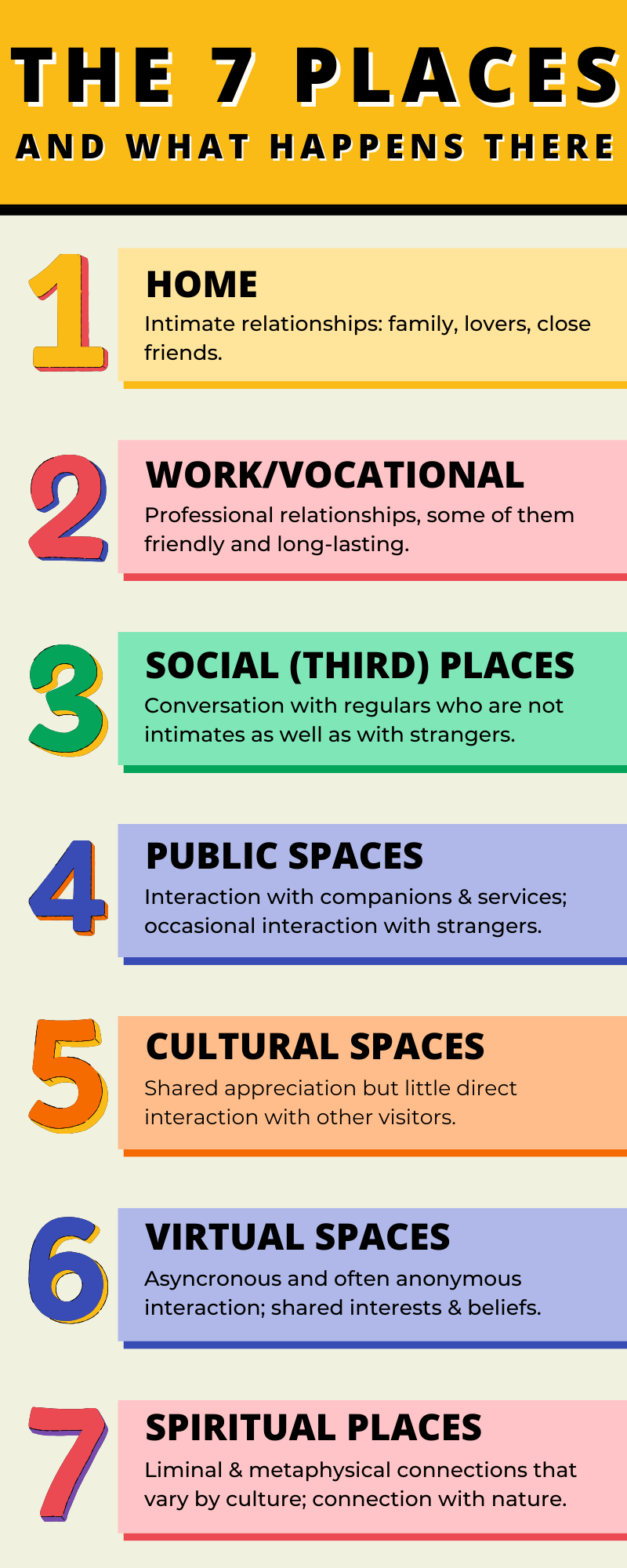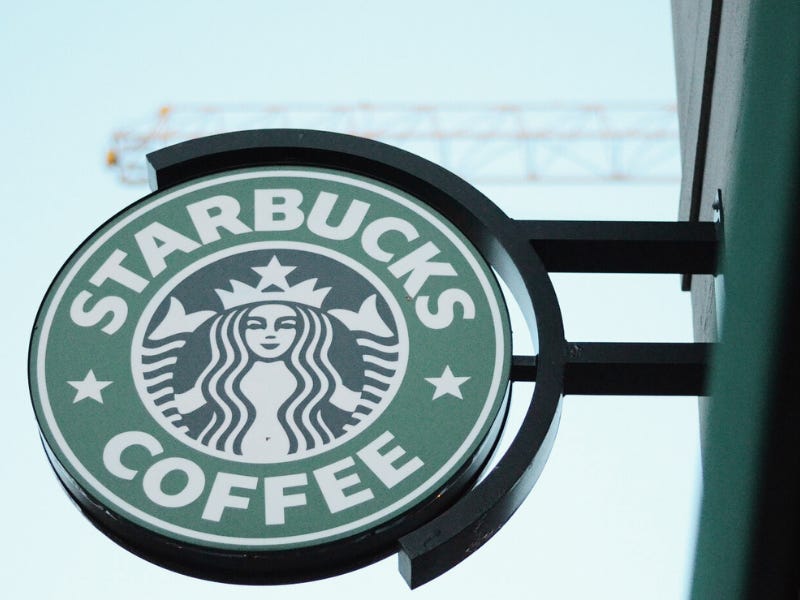The 7 Places (and Spaces)
A controversial list presented for discussion and debate
There’s been a great deal of discussion - and debate - about places and spaces, especially since the pandemic lockdowns. People make TikTok videos and YouTube videos about third places, and also about 4th places and 2-1/2 places. And it seems that people will call just about anything a third place. One article claimed that countries innovating in AI were “third place” nations - and not in the sense of bronze medals. You got me on that one - I couldn’t figure it out.
In any case, there really is some magic in the number 3.
Ray Oldenburg and a colleague first coined the term “third place” in 1983 in an academic article, and it became well-known in 1989 when The Great Good Place was published. Howard Schultz, founder and CEO of Starbucks used it so often that many people thought he had invented it. And I give Schultz credit for grasping what Ray was describing, even though Starbucks failed to be a third place.
Naturally, I’m trying to sort it out in the new The Great Good Place. I’ve ruffled feathers in the process. Finally, I decided to lay things out in terms of the objectives we have and what we experience in different places. This turned into an outline, a kind of placemaking taxonomy. I chose the number 7 because, like 3, 7 has symbolic resonance across cultures. (“Seventh heaven” is just one example.)
As you read through this outline, keep in mind that there are all kinds of great places that are not “third places.”
Two things were most important as I devised the outline. I wanted to clarify that while you might do some work in a third place, anywhere that has work as its primary purpose - which means you go there bearing responsibilities, with work objectives and professional relationships determined by others - is not what Ray Oldenburg identified as a third place. And I wanted to distinguish online/virtual spaces from all the real-life places we inhabit and benefit from. We are flesh-and-blood creatures, and social animals, and it is real-life places that mean the most - and that are the most accessible to all humans, rich or poor.
You’ll see a simple infographic above (it really ought to have some clouds and angels at the 7th level). A more expansive list is below. I know many people I’ve talked to will not agree with me and I hope those who read this letter will comment. These are not commandments from heaven, but a way to promote healthy, lively debate - just the kind of thing that happens in a third place!
1st Home (intimate relationships: family, lovers, close friends)
2nd Work/vocational venues (professional relationships, some of them friendly and long-lasting)
3rd Third places (casual connections with regulars who are not intimate friends; conversations with strangers; often businesses of some kind)
4th Public spaces with services and activities, including markets, parks, some libraries (interaction mostly with one’s companions and with service people; occasional interaction with strangers; generally publicly funded but may be charitable or part of a business)
5th Cultural spaces that provide education, inspiration, access to other worlds: libraries, museums (little direct interaction)
6th Online or virtual spaces and social media hubs (asyncronous and often anonymous interaction; shared interests)
7th Liminal or spiritual places (widely varied; included connection with nature, wilderness)
Another way to look at places is to analyze the feelings we have there and what we get out of the experience - topics at the heart of The Great Good Place. Ray and I also look at how third places contribute to the greater good.
What Starbucks tells us about America, and about ourselves
It’s no surprise that the timing of the US Thanksgiving Day is based on maximizing Christmas holiday spending, even though it’s ostensibly a harvest festival. The Canadian Thanksgiving is in October,…










Excited for the new edition Karen! You mention the recent fascination with the third space in online discussions, and people theorizing their own spacial linguistics. I had a question and a theory of my own regarding new frameworks for spaces.
The question: do you give any credence to these ideas of 2.5 spaces or overlapping spaces? For example, your home office being a 2nd space within a grander 1st space or the break room of an office being a 3rd space within a 2nd space. Are these separate microcosms, or should we focus more on the fluidity of environmental psychology? Curious to hear your thoughts.
As for my own theory, I like that you've expanded the categories to include more possibilities (again, encountering a new set of overlaps such as a church holding both 3rd and 7th space). However, there is something about the idea of "space" being too focused on our shaping of the environment and gives less regard to our natural relationships with the environment.
The theory: while you gave a name to these new spaces, I feel there is a missing space centered around novelty. This "novelty space" has a lot of metaphysical aspects related to humanity's relationship to the unknown, and I think it's a useful framework to explain a whole host of places. My experience working in the service industry helps me understand the core of what makes third spaces function, the most obvious being our need for community, but novelty introduces an entire different framework to explain why we go to spaces we have no psychological or environmental mapping.
Specific examples include vacations, new restaurants, an imagined Dungeons and Dragons world, an amusement park, etc. all directed by novelty-seeking behavior. I find these spaces to be just as important for our psyche as any other space, one where you interact with the world in a mental state of surprise or wonder. I'm writing up my own analysis of the environmental psychology around this missing space, would love to get your thoughts on it! Maybe the "unknown" is outside the bounds of the sociological frameworks you and Mr. Oldenburg are describing, but I still think there's a worthwhile thread to tug on.
I love this exploration of seven spaces. I would like to riff on them if I may. Not to improve them but to help my own thinking about them.
I see virtual spaces as a sort of shadow world. Not in the Jungian sense but as a mirror image of the real world where the outline shape remains but much of the detail and reality is lost. Shadows are not bad things. Peter Pan's shadow was a necessary and loved counterpoint to the light. Our shadows remind us that we are in the living light. But the virtual space, seen as a shadow, is flat and incomplete compared to the real worlds it needs to give it shape. All the other spaces, it seems to me, can have their virtual shadowns.
Public spaces are now often faux-public and their use is being restricted. Similarly cultural spaces -- although libraries are sometimes real world places for shared interests.
Shared interests (nee virtual spaces) include activism which can lead to friendship and home.
The spiritual space includes nature -- the ultimate real space that we need to explore our place in the world -- and can be both solitary and all-embracingly communual.
I tried to plot the spaces on a graph showing real to shadow (virtual) on the vertical axis and solitary to social on the horizontal axis. Spaces 1, 2, and 3 could pretty much fill the graph. Space 7, spiritual including nature in my terms) filled only part of lower shadow half of the graph but all of the top real half. Cultural (5), public (4) and shared interests (sort of 6) could only occupy smaller areas.
Yet another way of visualising the spaces -- I am so trying to explain this to myself -- is to create a "temple of connection" (drawing inspiration from the Toyota Lean House).
The four sides of the hipped roof represent four needs for a happy and fulfilled life:
- family and friendship
- occupation and vocation
- personal interests and social interaction
- spirituality and connection with nature.
(There is a touch of ikigai in all this.)
The four pillars represent physical spaces 1 to 3 and 7 -- home, work/voctional, social/third, and nature: all needed to support the roof.
The floor has patterned tiles representing supplementary spaces: the public, cultural, spiritual. Perhaps also the transactional -- we connect, albeit briefly, in shops, on public transport, and so on.
And then all this has a shadow, a virtual reflection of the physical.
That's it. Enough rambling. Thank you for prompting me to think about this.